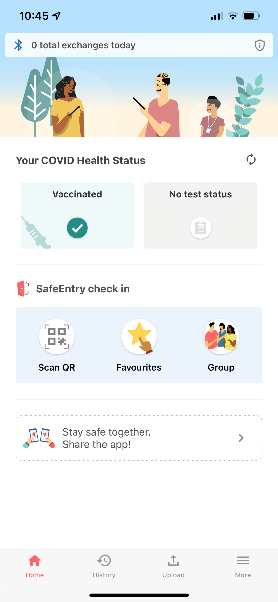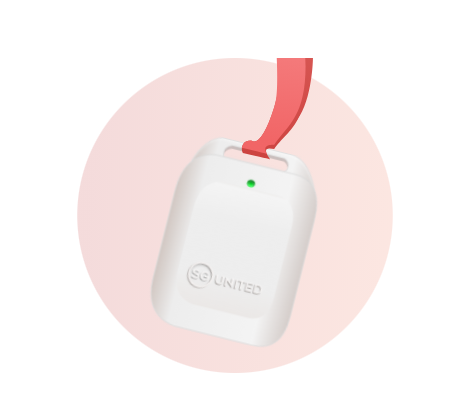Overview
To meet the rapidly evolving challenges arising from the COVID-19 pandemic, GovTech has leveraged its technological capabilities to develop TraceTogether, a digital solution that facilitates community-driven contact tracing via Bluetooth technology.
Contact tracing is imperative in managing the spread of COVID-19. Manual contact tracing often requires infected persons to recall the places they have been to and the people they have been in close and extended contact with. A hurdle that contact tracers often face is the inability of individuals to recall these details with precision. Coupled with a large disease outbreak like COVID-19, this can reduce the speed and comprehensiveness of contact tracing efforts.
To address this, GovTech’s Government Digital Services (GDS) team and the developed the TraceTogether mobile app (available on Android and iOS devices) and token to complement manual contact tracing efforts.
The TraceTogether mobile application is built on the BlueTrace protocol and its open-source code was published on GitHub to provide transparency on data usage and encourage co-creation of new technologies.
For an overview of how TraceTogether has supported Singapore’s COVID-19 journey, listen to our Government Chief Digital Technology Officer’s (GCDTO), Chan Cheow Hoe, 2020 podcast interview with the BBC here.
What is TraceTogether?
TraceTogether is a contact tracing technology that taps on Bluetooth to facilitate community-driven contact tracing through the logging of encounters between users. TraceTogether does not rely on the user’s memory and works with unacquainted contacts who are also TraceTogether programme participants. It therefore attempts to plug the gap of close contact with unacquainted contacts, by recording who you have been in contact with, but not where. In doing so, the privacy of users remains protected.
TraceTogether mobile application’s key features include:
Bluetooth technology: The app relies on the communication between Bluetooth-enabled devices to arrive at estimates of the proximity and duration of a user’s contact with other users.
-
TraceTogether approximates the distance between users by measuring the strength of the signals received from other Bluetooth devices (as a general rule, the stronger the signal received, the closer the transmitting device) participating in the programme.
-
It also approximates the duration of contact by interpolating successive communications between devices. The more often two devices communicate with each other, the longer the users are likely to have been within each other’s vicinity.
Data is secure and private: The data exchanged is anonymised, encrypted and stored only on users’ devices, and uploaded by the user to share with the Ministry of Health if they test positive for COVID-19. To further protect data privacy, locally stored information is automatically deleted after 25 days. The app will also cease functionality at the end of the outbreak.

TraceTogether Tokens
Not everyone has access to mobile devices. While this may only apply to a small percentage of the population, it is crucial that every member of the community is protected. TraceTogether tokens are physical alternatives to the TraceTogether mobile app, and function in a similar manner. Users have the option to use the token or the app interchangeably.
The token provides citizens with an alternative, which enables a more inclusive society for everyone to benefit from community-driven contact tracing.

TraceTogether Token’s key features include:
-
Bluetooth technology: Like the app, TraceTogether tokens send and detect Bluetooth signals to estimate a user’s contact proximity and duration with other users. Naturally, the app and tokens can communicate with each other.
-
Long-lasting battery: The battery is designed to run for six to nine months without charging.
-
No GPS receiver or internet connectivity: As with the app, no location data is kept by the device in any manner. The token is also incapable of uploading any data automatically since it will not be able to access the Internet. The data will be extracted for contact tracing when a user is a confirmed COVID-19 case.
-
Encrypted data: Proximity logs collected by the token will be encrypted. Furthermore, data is only stored on the device for 25 days before being automatically erased.
For more information on TraceTogether, visit the FAQ page here.
Why Should TraceTogether be Adopted?
The benefits of TraceTogether include:
-
Protect ourselves: Get notified quickly if you’ve been exposed to COVID-19 via close contact with an infected individual. Faster information means timely and efficient care for you.
-
Protect our loved ones: Being notified earlier also means that we can better protect those around us and reduce the transmission of COVID-19. This includes the vulnerable such as the elderly.
-
Protect our community: Going digital reduces the load on our frontline workers who would otherwise have to carry out manual contact tracing. TraceTogether enables community support and a safe way of carrying out activities normally.
How Do You Use TraceTogether?
Users can access TraceTogether by installing the mobile app on their smartphones.
A detailed installation guide that is available in multiple languages can be found here.
Alternatively, users can also collect a physical TraceTogether token (see collection details here).
Success Stories
The use of digital contact tracing enabled the government to go from taking an average of 2-3 days to do activity-mapping, to issuing a quarantine order in about one day. This time saved was made possible through integrating TraceTogether data with other data sources and systems, without disrupting mainstream processes. Validation results have shown a high degree of precision and corroboration between close contacts identified by TraceTogether and manual contact tracing. These measures led to cost savings by developing more scalable solutions that neither rely on heavy infrastructure nor require taxing manpower efforts. At the same time, having such initiatives are cost-effective alternatives to blanket lockdowns.
Since its launch, TraceTogether has also been made open-source for other countries to adopt. Post-launch, over 60 countries or cities have indicated interest in adopting a similar solution or learning from the team, with Australia, Canada, and Poland adopting the open-source version of TraceTogether.
At present, over 99% of people in Singapore are currently using TraceTogether to help stop the spread of COVID-19.
What's Next?
The team continues to take in feedback from relevant public channels to iteratively enhance the user experience, in line with public health measures and policies.
Contact Us
Reach out to the product team with your queries or feedback through this form.
Technical Resources
Last updated 09 July 2024
Thanks for letting us know that this page is useful for you!
If you've got a moment, please tell us what we did right so that we can do more of it.
Did this page help you? - No
Thanks for letting us know that this page still needs work to be done.
If you've got a moment, please tell us how we can make this page better.

